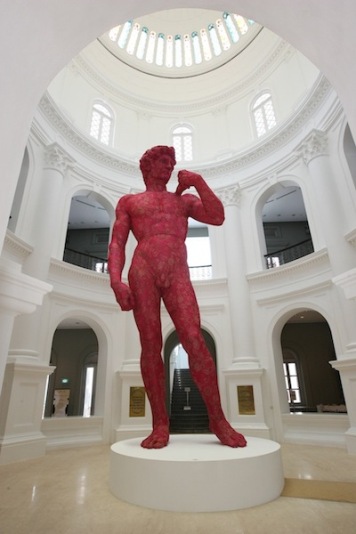by WULAN DIRGANTORO
 Despite the author’s concerns about the reception of the work Singaporean audiences loved ‘Surrounding David’ PHOTO/Titarubi
Despite the author’s concerns about the reception of the work Singaporean audiences loved ‘Surrounding David’ PHOTO/Titarubi
Titarubi’s art challenges masculinity in Indonesian visual arts and beyond
In 2008, visitors to the National Museum of Singapore were presented with a novel spectacle. Singapore’s art crowd is familiar with all kinds of contemporary art, but this was truly monumental, both literally and metaphorically. Entering the museum from the front door, visitors saw a giant pair of male legs in the familiar contrapposto position. Entering the rotunda of the museum, they would have recognised the work: it was a giant replica of Michelangelo’s famous sculpture David. However, the sculpture was 850 centimetres tall, nearly twice the height of the original sculpture and moreover, it was clad in skin-tight, neon-pink, floral brocade.
Surrounding David is an ambitious work from one of Indonesia’s prominent female artists, Titarubi. Born in Bandung in 1961, she completed her tertiary education in the Faculty of Fine Art and Design at the Bandung Institute of Technology in 1997, majoring in Ceramics. Currently residing in Yogyakarta, Titarubi is the co-founder and co-director of iCAN (Indonesian Contemporary Art Network), an arts management company whose projects reflect her diverse interests, from organising visual arts exhibitions and art residencies, to holding dance performances.
…
Attack of the brocade army
Exploring the body has emerged as a form of social, political and personal critique for many Indonesian women artists. Titarubi’s exploration of the intersections of art, medium and masculinity started in 2005 when she participated in the infamous CP Biennale 2005 Urban/Culture. Indonesia’s second international biennale was notorious for the controversy surrounding the installation Pink Swing Park. The installation featured Indonesian soap opera stars Anjasmara and Isabel Jahja in the nude within a post-apocalyptic garden. The ensuing media frenzy attracted the attention of Islamic hardliners, closed down the biennale, and ended with the artists (Agus Suwage and Davy Linggar), their models and the biennale organisers facing charges in court.
Inside Indonesia for more
